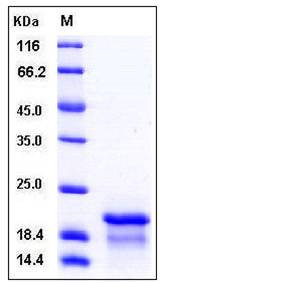Human NPM1 / Nucleophosmin Protein (His Tag)
B23,NPM
- 100ug (NPP4123) Please inquiry
| Catalog Number | P10053-H07E |
|---|---|
| Organism Species | Human |
| Host | E. coli |
| Synonyms | B23,NPM |
| Molecular Weight | The recombinant human NPM1 consisting of 161 amino acids and has a calculated molecular mass of 17.8 kDa. It migrates as an approximately 20 kDa band in SDS-PAGE under reducing conditions. |
| predicted N | Met |
| SDS-PAGE |  |
| Purity | > 90 % as determined by SDS-PAGE |
| Protein Construction | A DNA sequence encoding the human NPM1 isoform 1 (P06748-1) N-terminal segment (Met 9-Leu 158) was expressed, with a polyhistide tag at the N-terminus. |
| Bio-activity | |
| Research Area | Cancer |Signal transduction |Other Related Intracellular Topics |Other Genotoxic Stress Response Molecules |
| Formulation | Lyophilized from sterile PBS, pH 6.0 1. Normally 5 % - 8 % trehalose, mannitol and 0.01% Tween80 are added as protectants before lyophilization. Specific concentrations are included in the hardcopy of COA. |
| Background | Nucleophosmin 1 (NPM1), also known as nucleolar phosphoprotein B23 or numatrin, is a member of the nucleoplasmin family. Nucleophosmin (NPM) is a nucleolar phosphoprotein that plays multiple roles in ribosome assembly and transport, cytoplasmic-nuclear trafficking, centrosome duplication and regulation of p53. The NPM1 gene is frequently involved in chromosomal translocation, mutation and deletion. Mutations of the NPM1 gene leading to the expression of a cytoplasmic mutant protein, NPMc+, are the most frequent genetic abnormalities found in acute myeloid leukemias. Acute myeloid leukemias (AML) with mutated NPM1 have distinct characteristics, including a significant association with a normal karyotype, involvement of different hematopoietic lineages, a specific gene-expression profile and clinically, a better response to induction therapy and a favorable prognosis. In addition, NPM1 is a crucial gene to consider in the context of the genetics and biology of cancer. NPM1 is frequently overexpressed, mutated, rearranged and deleted in human cancer. Traditionally regarded as a tumour marker and a putative proto-oncogene, it has now also been attributed with tumour-suppressor functions. |
| Reference |
